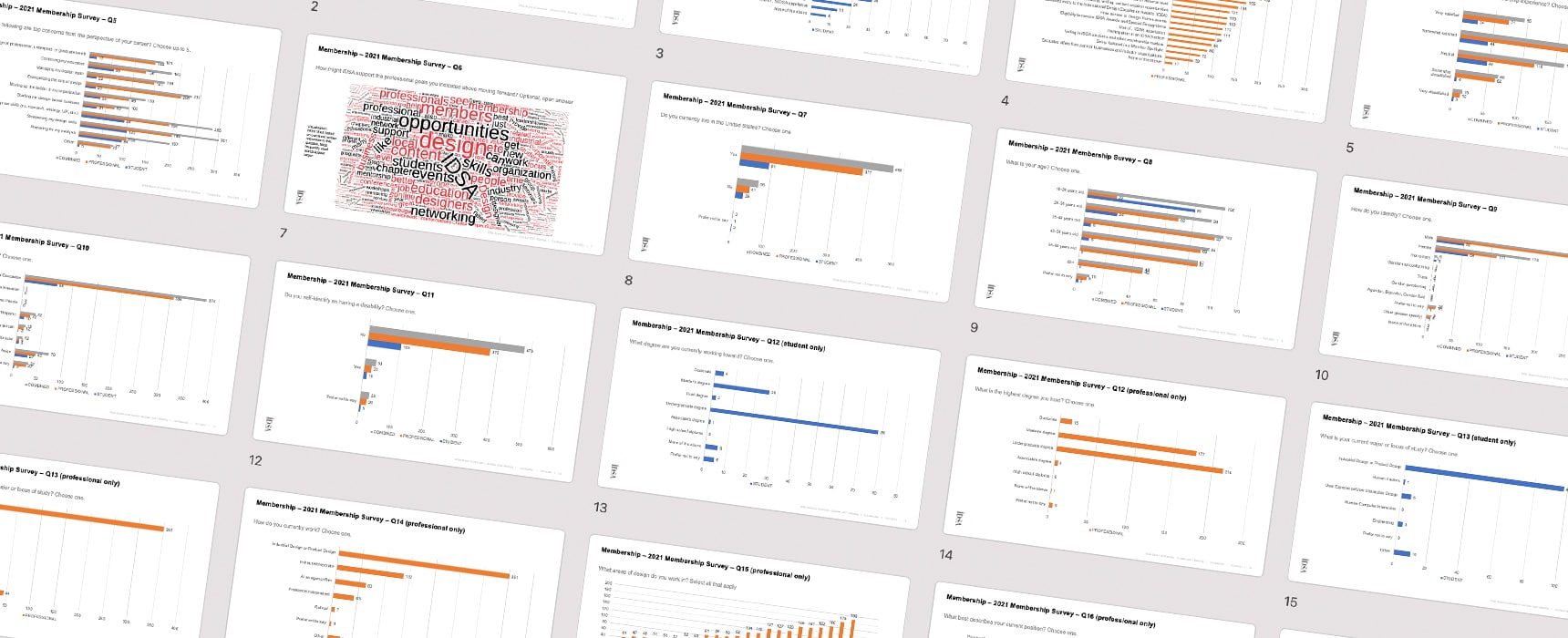Overview
IDSA is frequently asked for data and insights about the industrial design landscape across both the academic and professional spectrums. This might include everything from the distribution of designers in the US, the areas of practice, and salary ranges to gender, ethnicity, and sexual orientation. As a leading organization representing the field of ID, having this data allows us to better respond to these requests with a level of authority that is expected of us. The unfortunate reality we face is that the data we do have is often incomplete, outdated, and/or doesn’t present a clear picture of our profession. Knowing we could do better, and understanding the importance of our mission, we set out to create a new dataset that will serve as a baseline for all future efforts.
Our goal with this effort was to collect information in two primary areas: the basic demographics of our membership composition and how our members feel about the value of their IDSA membership. The data we received will help us improve our programming and forecast trends that impact the design community. Further, we want to begin a more regular cadence of data collection/analysis and eventually build it into an industrywide report that provides insights and voice to the more than 30,000 industrial designers working in the US (according to the US Bureau of Labor Statistics Occupational Outlook Report for Industrial Design, September 8, 2021).
Methodology
In June and July 2021, IDSA conducted its first membership survey since 2016. Staff worked independently and with members of the Diversity, Equity, and Inclusion Council Data Team to create a list of questions, which was deployed to IDSA members in the form of an anonymous survey. We also had input from IDSA’s Board of Directors and outside design researchers during the development of the survey. Different versions for students and professionals (with similar but targeted questions) were created. In total, the responses we received (550 total: 429 professionals, 121 students) represent roughly 21% of our membership. While this may seem low, this response rate represents a statistically significant sample size with a 5% margin of error and a 95% confidence level when applying the results across the membership.
Survey Results
IDSA Membership Benefits
Students: What benefits of IDSA student membership do you consider most valuable? (Top 5 Answers Shown)
- Participating in an IDSA Student Chapter (meetings, events, activities)
- Discounted pricing for conferences and events
- Free access to Design Voices events
- Participation in the annual Student Merit Awards
- Access to archived professional development videos/content
Professionals: What benefits of IDSA professional membership do you consider most valuable? (Top 5 Answers Shown)
- Receiving printed INNOVATION magazine quarterly (US only)
- Discounted pricing for conferences and events
- Participating in an IDSA Professional Chapter (meetings, events, activities)
- Access to the IDSA Membership Directory
- Access to archived professional development videos/content
IDSA Membership Demographics
Students & Professionals: What is your age?

Students & Professionals: How do you identify? (Gender)

Students & Professionals: What best describes you? (Ethnicity)

Students & Professionals: Do you self-identify as having a disability?

Industrial Design Profession
Students & Professionals: Which of the following are top concerns from the perspective of your career? (Choose up to 5)

Students: What degree are you currently working toward?

Students: What is your current major or focus of study?

Professionals: What is the highest degree you hold?

Professionals: What was your major or focus of study?

Professionals: What professional practice areas of design do you work in?

Professionals: How do you currently work?

Professionals: What best describes your current position?

Professionals: What is the size of your design team?

Professionals: What is your annual compensation?

Conclusions
It is important to remember that the data presented here is a mere snapshot of IDSA’s current membership community and an even smaller fraction of the entire industrial design profession in the United States. Care should be taken when making any broad applications or assumptions of the information provided as it may not directly correlate to other known industry-wide trends or demographic breakdowns. It’s also unclear how the ongoing COVID-19 pandemic may have influenced participation rates or responses.
There is a lot to unpack in the information collected by this survey and visualized in these charts. Some of the early insights we’ve gleaned from this survey have already influenced our plans and strategies for the year(s) ahead. IDSA’s staff, Board of Directors, and members of the Diversity, Equity, Inclusion Council continue to analyze and revisit the data in an ongoing and iterative cycle. This effort to learn more about our wide spectrum of programmatic and membership experiential touchpoints is in turn helping us become more efficient and effective in providing a high-quality service to our community.
We are tremendously thankful to those in our membership who took time to complete the survey and provide us with their valuable feedback.
Further, we know there are macro and micro trends which influence the industrial design profession at large, as well as the day-to-day experience that members have with IDSA. Now with this survey (and hopefully many more like it in the future) we can begin to understand how these forces relate to one another and correspond to the changes we’ve seen over time in design studios, academic classrooms, and local design communities across the country. This work is profoundly important as we move forward and is a cornerstone of IDSA’s mission of advocacy for the profession of industrial design.
